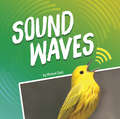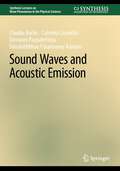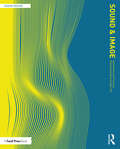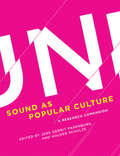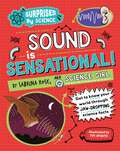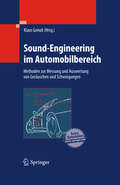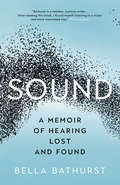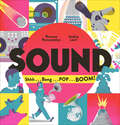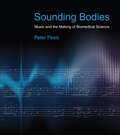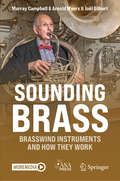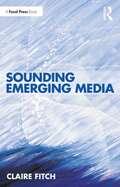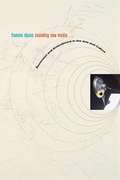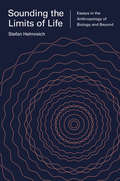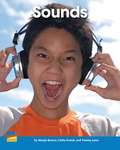- Table View
- List View
Sound Waves (Waves in Motion)
by Michael DahlBirds chirp. A dog barks. Thunder claps. We hear sounds all around us. But how? Sound waves travel through the air, but we don't see them. With engaging, at-level text and colorful images, readers will learn about sound waves and how we use them every day.
Sound Waves and Acoustic Emission (Synthesis Lectures on Wave Phenomena in the Physical Sciences)
by Claudia Barile Caterina Casavola Giovanni Pappalettera Vimalathithan Paramsamy KannanThe nature of sound is, nowadays, well known and understood so that sound could be synthetically described like the propagation of vibration in elastic media.Sound waves propagate as longitudinal waves, transverse waves, or in mixed modes in different media. The development of applications related to the proper management of the information connected with sound waves. This is the case of so-called acoustic emission. This book introduces the basics of sound waves, their types, propagation in different modes, velocities, and other properties It also introduces the basics of acoustic emission and the different sources of acoustic emission. This book delivers different propagation modes, their significance, and the attenuation and distortion of acoustic waves. One of the overlooked applications of acoustic emission, the acousto-ultrasonic approach is introduced and discussed with practical applications.
Sound and Image: Aesthetics and Practices (Sound Design)
by Andrew Knight-HillSound and Image: Aesthetics and Practices brings together international artist scholars to explore diverse sound and image practices, applying critical perspectives to interrogate and evaluate both the aesthetics and practices that underpin the audiovisual. Contributions draw upon established discourses in electroacoustic music, media art history, film studies, critical theory and dance; framing and critiquing these arguments within the context of diverse audiovisual practices. The volume’s interdisciplinary perspective contributes to the rich and evolving dialogue surrounding the audiovisual, demonstrating the value and significance of practice-informed theory, and theory derived from practice. The ideas and approaches explored within this book will find application in a wide range of contexts across the whole scope of audiovisuality, from visual music and experimental film, to narrative film and documentary, to live performance, sound design and into sonic art and electroacoustic music. This book is ideal for artists, composers and researchers investigating theoretical positions and compositional practices which bring together sound and image.
Sound and Light (Science Explorer)
by The Editors at the Prentice HallLearn more about sound and light through these interesting experiments!
Sound and Noise: A Listener's Guide to Everyday Life
by Marcia Jenneth EpsteinThis book is about how you listen and what you hear, about how to have a dialogue with the sounds around you. Marcia Jenneth Epstein gives readers the impetus and the tools to understand the sounds and noise that define their daily lives in this groundbreaking interdisciplinary study of how auditory stimuli impact both individuals and communities. Epstein employs scientific and sociological perspectives to examine noise in multiple contexts: as a threat to health and peace of mind, as a motivator for social cohesion, as a potent form of communication and expression of power. She draws on a massive base of specialist literature from fields as diverse as nursing and neuroscience, sociology and sound studies, acoustic ecology and urban planning, engineering, anthropology, and musicology, among others, synthesizing and explaining these findings to evaluate the ubiquitous effects of sound in everyday life. Epstein investigates speech and music as well as noise and explores their physical and cultural dimensions. Ultimately she argues for an engaged public dialogue on sound, built on a shared foundation of critical listening, and provides the understanding for all of us to speak and be heard in such a discussion. Sound and Noise is a timely evaluation of the noise that surrounds us, how we hear it, and what we can do about it.
Sound as Popular Culture: A Research Companion
by Holger Schulze Jens Gerrit PapenburgScholars consider sound and its concepts, taking as their premise the idea that popular culture can be analyzed in an innovative way through sound.The wide-ranging texts in this book take as their premise the idea that sound is a subject through which popular culture can be analyzed in an innovative way. From an infant's gurgles over a baby monitor to the roar of the crowd in a stadium to the sub-bass frequencies produced by sound systems in the disco era, sound—not necessarily aestheticized as music—is inextricably part of the many domains of popular culture. Expanding the view taken by many scholars of cultural studies, the contributors consider cultural practices concerning sound not merely as semiotic or signifying processes but as material, physical, perceptual, and sensory processes that integrate a multitude of cultural traditions and forms of knowledge.The chapters discuss conceptual issues as well as terminologies and research methods; analyze historical and contemporary case studies of listening in various sound cultures; and consider the ways contemporary practices of sound generation are applied in the diverse fields in which sounds are produced, mastered, distorted, processed, or enhanced. The chapters are not only about sound; they offer a study through sound—echoes from the past, resonances of the present, and the contradictions and discontinuities that suggest the future.ContributorsKarin Bijsterveld, Susanne Binas-Preisendörfer, Carolyn Birdsall, Jochen Bonz, Michael Bull, Thomas Burkhalter, Mark J. Butler, Diedrich Diederichsen, Veit Erlmann, Franco Fabbri, Golo Föllmer, Marta García Quiñones, Mark Grimshaw, Rolf Großmann, Maria Hanáček, Thomas Hecken, Anahid Kassabian, Carla J. Maier, Andrea Mihm, Bodo Mrozek, Carlo Nardi, Jens Gerrit Papenburg, Thomas Schopp, Holger Schulze, Toby Seay, Jacob Smith, Paul Théberge, Peter Wicke, Simon Zagorski-Thomas
Sound is Sensational! (Surprised by Science #4)
by Sabrina Rose Science GirlBe surprised by the astonishing science of sound, with Sabrina Rose, AKA Science Girl, the internet's most inspiring curator of facts and observations of our wonderful world - making it easy for all readers to come to love science!Surprised by Science: Sound is Sensational brings an attention-grabbing and accessible set of facts about sound to life! Doing what she's famous for online, Sabrina Rose dives into the most surprising details of the world of sound and physics to explore the science at work. From sounds among animals, to sounds in different shapes; from the loudest sound, to sounds humans can't hear at all - this series is perfect for inquisitive children age 7 and up, and all fans of Science Girl.Contents: What is Sound? / Sensational Sound Waves / Ears: Outside and In / We've Got Sound on the Brain / How Animals Use Sound / Sounds We Can't Hear / What's the Buzz? / Plant Sounds / How Sound Travels / The Art of Sound / Sound Extremes / Nature's Wildest Sounds / Surprised by Scientific Discoveries / Glossary / Further Information / IndexSurprised by Science is a series of books that takes the inspiring communication and research skills of Science Girl's hugely popular platform and distills it on the page, with funny and engaging illustrations by Pipi Sposito paired with photos of the real-life science in action. The series includes: Electricity is Epic!; Plants are Powerful!; Forces are Fantastic!; Sound is Sensational!; Animals are Awesome!; Human Bodies are Brilliant!
Sound-Engineering im Automobilbereich
by Klaus GenuitMit steigenden Kundenansprüchen gewinnen die Fragen unerwünschter Geräusche im Kraftfahrzeug zunehmend an Bedeutung. Sie begleiten Ingenieure im Automobilbereich von der Konzept- bis zur Serienphase. Dabei ist das Thema stets im Kontext weiterer Entwicklungsfelder wie Antrieb oder Aerodynamik zu betrachten. Das Überblickswerk bietet die Möglichkeit, sich schnell in das Thema einzuarbeiten und schnell auf Grundlagen und Details zugreifen zu können. Dabei werden die Themen Fahrzeuginnengeräusche und Fahrzeugaußengeräusche gleichermaßen behandelt.
Sound: A Memoir of Hearing Lost and Found
by Bella Bathurst&“A moving and fascinating book about sound and what it means to be human&” from the Somerset Maugham Award–winning author of The Lighthouse Stevensons (Financial Times). In this surprising and moving book, award-winning writer Bella Bathurst shares the extraordinary true story of how she lost her hearing and eventually regained it and what she learned from her twelve years of deafness. Diving into a wide-ranging exploration of silence and noise, she interviews psychologists, ear surgeons, and professors to uncover fascinating insights about the science of sound. But she also speaks with ordinary people who are deaf or have lost their hearing, including musicians, war veterans, and factory workers, to offer a perceptive, thought-provoking look at what sound means to us. If sight gives us the world, then hearing—or our ability to listen—gives us our connections with other people. But, as this smart, funny, and profoundly honest examination reveals, our relationship with sound is both more personal and far more complex than we might expect. &“Bathurst is a restless, curious writer . . . After reading this book, I found myself listening in a richer and more interested way.&” —The Guardian &“A hymn to the faculty of hearing by someone who had it, lost it and then found it again, written with passion and intelligence . . . terrifying, absorbing and ultimately uplifting.&” —Literary Review &“Bathurst&’s affecting memoir will enlighten and educate.&” —Publishers Weekly &“A memoir of hearing loss and what the author learned . . . through her unexpected recovery from it. A good writer knows material when it presents itself, and Bathurst is a very good writer.&” —Kirkus Reviews
Sound: A Question and Answer Book (Fact Finders)
by Fiona BayrockThe book introduces the concepts of sound waves, vibration, and energy, and presents how humans perceive and produce different sounds
Sound: From Whisper to Rock Band
by Christopher CooperWhat is sound? How does sound move through air and water? Why are some sounds high in pitch and others are low? Investigate the curious world of physical science! Find out for yourself about Sound through experiments that you can do at home. Did you know that some animals hear sounds that you cannot hear? Sound will show you the importance of investigating and understanding the physical world around you.
Sound: Shhh . . . Bang . . . POP . . . BOOM!
by Romana Romanyshyn Andriy LesivWhat does sound look like? &“Comprehensively describes [sound&’s] qualities, sources, and uses . . . A joyful moment of reflection on our noisy, cacophonous world.&” —School Library Journal Informative and endlessly fascinating, this book makes visible that which we otherwise only hear and feel as vibrations: SOUND. Authors and artists Romana Romanyshyn and Andriy Lesiv achieve a remarkable fusion of a scientific exploration of the phenomenon of sound with a philosophic reflection on its nature that will appeal to inquisitive children looking to learn more about science and how our bodies work. Stunning infographics provoke the reader to listen, learn, and think. Whether it&’s hearing noise, music, speech—or silence—no one will come away from these pages without experiencing sound with new ears and a fresh understanding. Winner (with its companion volume, Sight), Bologna Ragazzi Award, Best Nonfiction Book of the Year &“This attention-grabbing informational book starts with a bang: a rapid-fire tour of all things sound. Chock-full of whimsical infographics . . . A quiet meditation on hearing, listening, silence, communication, and understanding.&” —The Horn Book Magazine &“This vibrant picture book is particularly wonderful when the text focuses on music and melody; the music of life is everywhere, from speech to nature, from trombones to gramophones, from rumbling bellies to crying babies. The absence of sound is explored as well—communicating in sign language, meditating, or simply being present in quiet moments with loved ones. . . . A great discussion-starter for elementary school children.&” —School Library Journal &“A compelling foray into the many aspects of sound.&” —Publishers Weekly
Sound: Shhh . . . Bang . . . POP . . . BOOM!
by Romana Romanyshyn Andriy LesivWhat does sound look like? &“Comprehensively describes [sound&’s] qualities, sources, and uses . . . A joyful moment of reflection on our noisy, cacophonous world.&” —School Library Journal Informative and endlessly fascinating, this book makes visible that which we otherwise only hear and feel as vibrations: SOUND. Authors and artists Romana Romanyshyn and Andriy Lesiv achieve a remarkable fusion of a scientific exploration of the phenomenon of sound with a philosophic reflection on its nature that will appeal to inquisitive children looking to learn more about science and how our bodies work. Stunning infographics provoke the reader to listen, learn, and think. Whether it&’s hearing noise, music, speech—or silence—no one will come away from these pages without experiencing sound with new ears and a fresh understanding. Winner (with its companion volume, Sight), Bologna Ragazzi Award, Best Nonfiction Book of the Year &“This attention-grabbing informational book starts with a bang: a rapid-fire tour of all things sound. Chock-full of whimsical infographics . . . A quiet meditation on hearing, listening, silence, communication, and understanding.&” —The Horn Book Magazine &“This vibrant picture book is particularly wonderful when the text focuses on music and melody; the music of life is everywhere, from speech to nature, from trombones to gramophones, from rumbling bellies to crying babies. The absence of sound is explored as well—communicating in sign language, meditating, or simply being present in quiet moments with loved ones. . . . A great discussion-starter for elementary school children.&” —School Library Journal &“A compelling foray into the many aspects of sound.&” —Publishers Weekly
Sounding Bodies: Acoustical Science and Musical Erotics in Victorian Literature (SUNY series, Studies in the Long Nineteenth Century)
by Shannon DrauckerCan the concert hall be as erotic as the bedroom? Many Victorian writers believed so. In the mid-nineteenth century, acoustical scientists such as Hermann von Helmholtz and John Tyndall described music as a set of physical vibrations that tickled the ear, excited the nerves, and precipitated muscular convulsions. In turn, writers—from canonical figures such as George Eliot and Thomas Hardy, to New Women novelists like Sarah Grand and Bertha Thomas, to anonymous authors of underground pornography—depicted bodily sensations and experiences in unusually explicit ways. These writers used scenes of music listening and performance to intervene in urgent conversations about gender and sexuality and explore issues of agency, pleasure, violence, desire, and kinship. Sounding Bodies shows how both classical music and Victorian literature, while often considered bastions of conservatism and repression, represented powerful sites for feminist and queer politics.
Sounding Bodies: Music and the Making of Biomedical Science
by Peter PesicThe unfolding influence of music and sound on the fundamental structure of the biomedical sciences, from ancient times to the present.Beginning in ancient Greece, Peter Pesic writes, music and sound significantly affected the development of the biomedical sciences. Physicians used rhythmical ratios to interpret the pulse, which inspired later efforts to record the pulse in musical notation. After 1700, biology and medicine took a &“sonic turn,&” viewing the body as a musical instrument, the rhythms and vibrations of which could guide therapeutic insight. In Sounding Bodies, Pesic traces the unfolding influence of music and sound on the fundamental structure of the biomedical sciences. Pesic explains that music and sound provided the life sciences important tools for hearing, understanding, and influencing the rhythms of life. As medicine sought to go beyond the visible manifestations of illness, sound offered ways to access the hidden interiority of body and mind. Sonic interventions addressed the search for a new typology of mental illness, and practitioners used musical instruments to induce hypnotic states meant to cure both psychic and physical ailments. The study of bat echolocation led to the manifold clinical applications of ultrasound; such sonic devices as telephones and tuning forks were used to explore the functioning of the nerves. Sounding Bodies follows Pesic&’s Music and the Making of Modern Science and Polyphonic Minds to complete a trilogy on the influence of music on the sciences. Enhanced digital editions of Sounding Bodies offer playable music and sound examples.
Sounding Brass: Brasswind Instruments And How They Work
by Arnold Myers Murray Campbell Joël GilbertA lone bugler sounds the Last Post at a Festival of Remembrance. Overlapping horn arpeggios conjure up the flowing waters of the Rhine in Wagner&’s opera &“Das Rheingold&”. Seventy-six trombones lead the big parade; trumpets sound ceremonial fanfares, and power the horn sections in jazz and funk bands. The sounds of brass instruments enrich many of our most inspiring musical experiences. But what defines a &“brass instrument&”? How is a stream of air blown through a small gap in the player&’s lips transformed into a sound which fills a concert hall? When did brass instruments originate, and how did they evolve into the instruments of the modern orchestra? These are some of the questions addressed in this book. The authors, professional scientists but also experienced brass players, explain how recent research has illuminated our understanding of brass instruments. The presentation is aimed at a general readership, including players, teachers, and lovers of all types of music. No mathematical background is assumed. Descriptions of many experiments on brass instruments carried out by the authors and others bring out the musical significance of the results. A novel approach to the systematic classification of brass instruments is outlined and graphically illustrated. Separate chapters are devoted to trumpets and related instruments, horns, trombones, tubas, brass instruments with toneholes, and instruments from antiquity including the Celtic carnyx. The final chapter reviews the application of electronic enhancement techniques to brass instruments. The book is generously illustrated with colour photographs, musical examples, and explanatory figures.
Sounding Emerging Media
by Claire FitchSounding Emerging Media details a practice-based approach to sonic art and electroacoustic composition, drawing on methodologies inspired by the production of electronic literature, and game development. Using the structural concepts identified by Gilles Deleuze and Félix Guattari, the book is based around ideas related to labels such as Assemblage, Strata, Smooth and Striated Space, Temporal Space and, The Fold. The processes employed to undertake this research involved the creation of original texts, the development of frameworks for improvisation, the use of recordings within the process and implementation of techniques drawn from the practices of electroacoustic composition, and the use of ideas borrowed from electronic literature, publishing and game development. The results have helped to shape a compositional style which draws on these processes individually or collectively, drawing on practice often seen in game development, visual scores and composition using techniques found in electroacoustic music. Providing a journey through the landscape of emerging digital media, Sounding Emerging Media envisages a world where the composer/user/listener all become part of a continuum of collective artistry. This book is the ideal guide to the history and creation of audio for innovative digital media formats and represents crucial reading for both students and practitioners, from aspiring composers to experienced professionals.
Sounding New Media: Immersion and Embodiment in the Arts and Culture
by Frances DysonThe concept of embodiment, as either a site of resistance to technological incorporation, or a site of excess toward which technology will always aim but never arrive, is no longer adequate to represent the realities of technoculture.
Sounding the Limits of Life
by Stefan Helmreich Michele Friedner Sophia RoosthWhat is life? What is water? What is sound? In Sounding the Limits of Life, anthropologist Stefan Helmreich investigates how contemporary scientists--biologists, oceanographers, and audio engineers--are redefining these crucial concepts. Life, water, and sound are phenomena at once empirical and abstract, material and formal, scientific and social. In the age of synthetic biology, rising sea levels, and new technologies of listening, these phenomena stretch toward their conceptual snapping points, breaching the boundaries between the natural, cultural, and virtual.Through examinations of the computational life sciences, marine biology, astrobiology, acoustics, and more, Helmreich follows scientists to the limits of these categories. Along the way, he offers critical accounts of such other-than-human entities as digital life forms, microbes, coral reefs, whales, seawater, extraterrestrials, tsunamis, seashells, and bionic cochlea. He develops a new notion of "sounding"--as investigating, fathoming, listening--to describe the form of inquiry appropriate for tracking meanings and practices of the biological, aquatic, and sonic in a time of global change and climate crisis.Sounding the Limits of Life shows that life, water, and sound no longer mean what they once did, and that what count as their essential natures are under dynamic revision.
Soundings: The Story of the Remarkable Woman Who Mapped the Ocean Floor
by Hali Felt“A fascinating account of a woman working without much recognition . . . to map the ocean floor and change the course of ocean science.” —San Francisco ChronicleSoundings is the story of the enigmatic woman behind one of the greatest achievements of the 20th century. Before Marie Tharp, geologist and gifted draftsperson, the whole world, including most of the scientific community, thought the ocean floor was a vast expanse of nothingness. In 1948, at age 28, Marie walked into the geophysical lab at Columbia University and practically demanded a job. The scientists at the lab were all male. Through sheer willpower and obstinacy, Marie was given the job of interpreting the soundings (records of sonar pings measuring the ocean’s depths) brought back from the ocean-going expeditions of her male colleagues. The marriage of artistry and science behind her analysis of this dry data gave birth to a major work: the first comprehensive map of the ocean floor, which laid the groundwork for proving the then-controversial theory of continental drift.Marie’s scientific knowledge, her eye for detail and her skill as an artist revealed not a vast empty plane, but an entire world of mountains and volcanoes, ridges and rifts, and a gateway to the past that allowed scientists the means to imagine how the continents and the oceans had been created over time.Hali Felt brings to vivid life the story of the pioneering scientist whose work became the basis for the work of others scientists for generations to come.“Felt’s enthusiasm for Tharp reaches the page, revealing Tharp, who died in 2006, to be a strong-willed woman living according to her own rules.” —The Washington Post
Sounds
by Tammy Jones Margie Burton Cathy FrenchThis book is about the different types of sounds and how sound is created.
Sounds All Around (Let's-Read-and-Find-Out Science #1)
by Wendy PfefferSounds are all around us. Clap your hands, snap your fingers: You’re making sounds. Read and find out how people and animals use different kinds of sounds to communicate. With colorful illustrations from Anna Chernyshova and engaging text from Wendy Pfeffer, Sounds All Around is a fascinating look into how sound works! <P><P>Featuring rich vocabulary bolded throughout the text, this brand-new edition of a 1999 title includes brand-new illustrations by Anna Chernyshova. This book also includes a Find Out More section with additional and updated experiments, such as finding out how sound travels through water. Both the text and the artwork were vetted by Dr. Agnieszka Roginska, Professor of Music Technology at NYU. <P><P>This is a Level 1 Let’s-Read-and-Find-Out, which means the book explores introductory concepts perfect for children in the primary grades and supports the Common Core Learning Standards, Next Generation Science Standards, and the Science, Technology, Engineering, and Math (STEM) standards. Let’s-Read-and-Find-Out Science is the winner of the American Association for the Advancement of Science/Subaru Science Books & Films Prize for Outstanding Science Series.
